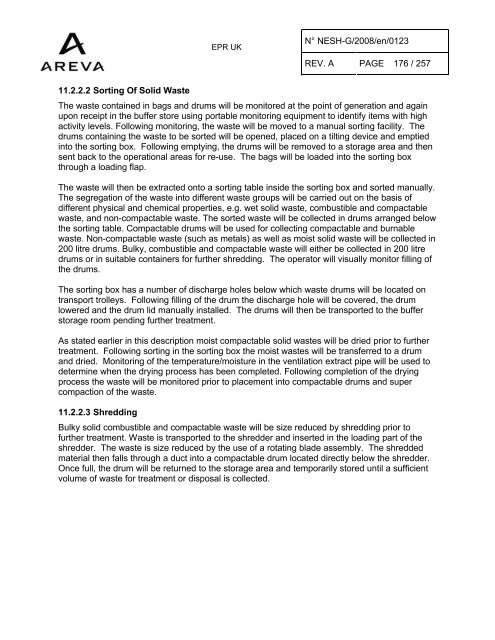Solid Radioactive Waste Strategy Report.pdf - UK EPR
Solid Radioactive Waste Strategy Report.pdf - UK EPR
Solid Radioactive Waste Strategy Report.pdf - UK EPR
You also want an ePaper? Increase the reach of your titles
YUMPU automatically turns print PDFs into web optimized ePapers that Google loves.
<strong>EPR</strong> <strong>UK</strong><br />
N° NESH-G/2008/en/0123<br />
REV. A PAGE 176 / 257<br />
11.2.2.2 Sorting Of <strong>Solid</strong> <strong>Waste</strong><br />
The waste contained in bags and drums will be monitored at the point of generation and again<br />
upon receipt in the buffer store using portable monitoring equipment to identify items with high<br />
activity levels. Following monitoring, the waste will be moved to a manual sorting facility. The<br />
drums containing the waste to be sorted will be opened, placed on a tilting device and emptied<br />
into the sorting box. Following emptying, the drums will be removed to a storage area and then<br />
sent back to the operational areas for re-use. The bags will be loaded into the sorting box<br />
through a loading flap.<br />
The waste will then be extracted onto a sorting table inside the sorting box and sorted manually.<br />
The segregation of the waste into different waste groups will be carried out on the basis of<br />
different physical and chemical properties, e.g. wet solid waste, combustible and compactable<br />
waste, and non-compactable waste. The sorted waste will be collected in drums arranged below<br />
the sorting table. Compactable drums will be used for collecting compactable and burnable<br />
waste. Non-compactable waste (such as metals) as well as moist solid waste will be collected in<br />
200 litre drums. Bulky, combustible and compactable waste will either be collected in 200 litre<br />
drums or in suitable containers for further shredding. The operator will visually monitor filling of<br />
the drums.<br />
The sorting box has a number of discharge holes below which waste drums will be located on<br />
transport trolleys. Following filling of the drum the discharge hole will be covered, the drum<br />
lowered and the drum lid manually installed. The drums will then be transported to the buffer<br />
storage room pending further treatment.<br />
As stated earlier in this description moist compactable solid wastes will be dried prior to further<br />
treatment. Following sorting in the sorting box the moist wastes will be transferred to a drum<br />
and dried. Monitoring of the temperature/moisture in the ventilation extract pipe will be used to<br />
determine when the drying process has been completed. Following completion of the drying<br />
process the waste will be monitored prior to placement into compactable drums and super<br />
compaction of the waste.<br />
11.2.2.3 Shredding<br />
Bulky solid combustible and compactable waste will be size reduced by shredding prior to<br />
further treatment. <strong>Waste</strong> is transported to the shredder and inserted in the loading part of the<br />
shredder. The waste is size reduced by the use of a rotating blade assembly. The shredded<br />
material then falls through a duct into a compactable drum located directly below the shredder.<br />
Once full, the drum will be returned to the storage area and temporarily stored until a sufficient<br />
volume of waste for treatment or disposal is collected.

















